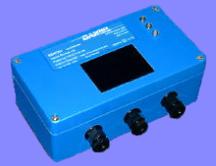
|
Features
|
SENTRY INTRINSICALLY SAFE CARD READER
The Sentry card reader is designed for hazardous and non-hazardous harsh area use and can be configured to read a range of different card technologies.
Certified to EEx ia IIC T4, the Sentry is intrinsically safe and therefore suitable for use in the most hazardous of areas, including those classified as Zone 0, where there is a constant risk of an explosive atmosphere.
The Sentry has CENELEC European approval and also has the equivalent F.M. approval and is therefore suitable for use in the U.S.A.
The Sentry comprises a weatherproof box housing the electronics required to format the card data for transmission to a host computer and a card reader head. One of several card reader head options may be fitter to this box. This determines the card media type that can be decoded, which can be any of the following:
Proximity card: a non-contact technology where a card is read by passing it within a few centimetres of a plastic window on the front of the Sentry. As the proximity technology is non-contact, the identification media can take a number of different formats and a key fob device is available as an alternative to the standard proximity card.
Wiegand card: a swipe card where data is encoded on wires embedded securely within the card.
Barcode and Magnetic stripe card technologies are also under development taking advantage of the Sentry's modular design.
Operation
The intrinsically safe Sentry communicates via the barrier and communications interface (R007-IS) in the safe area, where the signal becomes available as RS-232, RS-422 or RS-485 serial data. The Sentry can be multi-dropped at the RS-485 serial data point whereby up to 64 Sentry barriers can be chained together and connected to a single control port on the host. The Sentry can also communicate via a Mercury terminal.
The safe area version of the Sentry has RS-422 and RS-485 directly avaiable and does not need the R007 barrier.
For maximum flexibility and ease of use, all communication between the Sentry and its host is ASCII, and is derived from the VT-100 standard. Commands are a sub-set of those used by the Mercury terminal.
A successful read is indicated by the LED and the card data is then transmitted to the safe area when requested by the host. Other visual indicators are provided as detailed below.
A bi-colour LED is provided to indicate that the Sentry is powered. This changes briefly from green to red on each successful card read.
A second LED is under full control of the host computer and its application is therefore user defined.
An additional LED is fitted to Sentries equipped with a proximity card read head. This remains illuminated whenever a proximity card is in range of the sensing window.
The format of the data transmission is determined by the links inside the Sentry and also by the set up process which involves downloading options from a PC or terminal. The card reader's internal links determine the type of card reader used and allow remote configuration to take place.
Advanced settings include data format, multi-drop settings and communication parameters.
All other options are set using the remote configuration mode.
The Sentry also provides two isolated digital outputs, two digital inputs, and two inputs for proximity switches suitable for card present detection. These are directly controlled and read by the host computer.